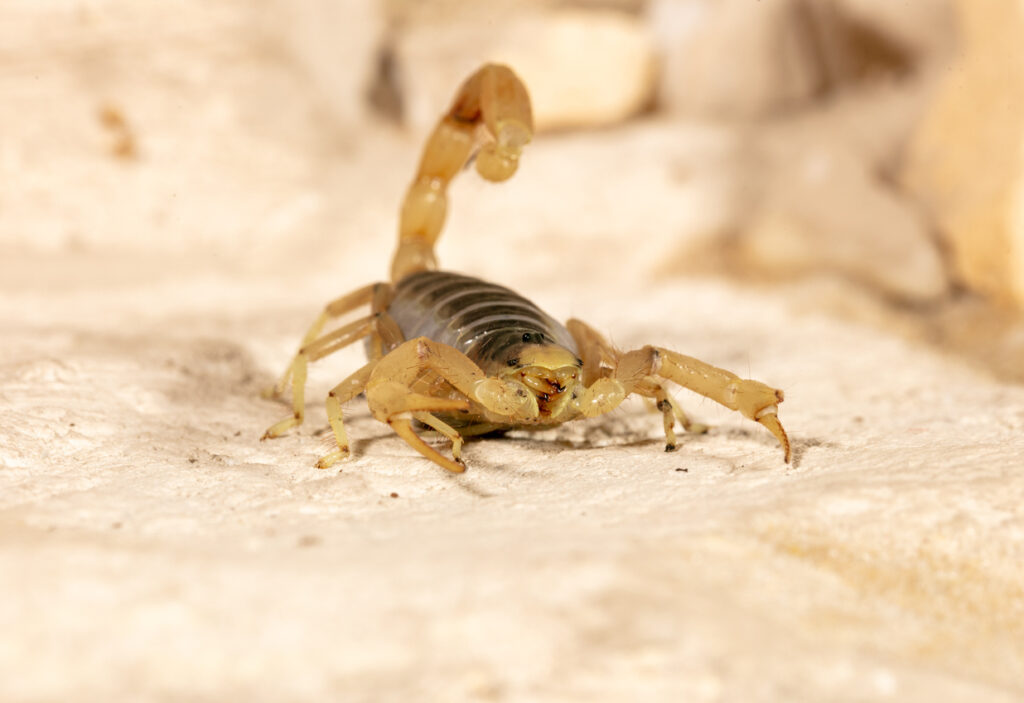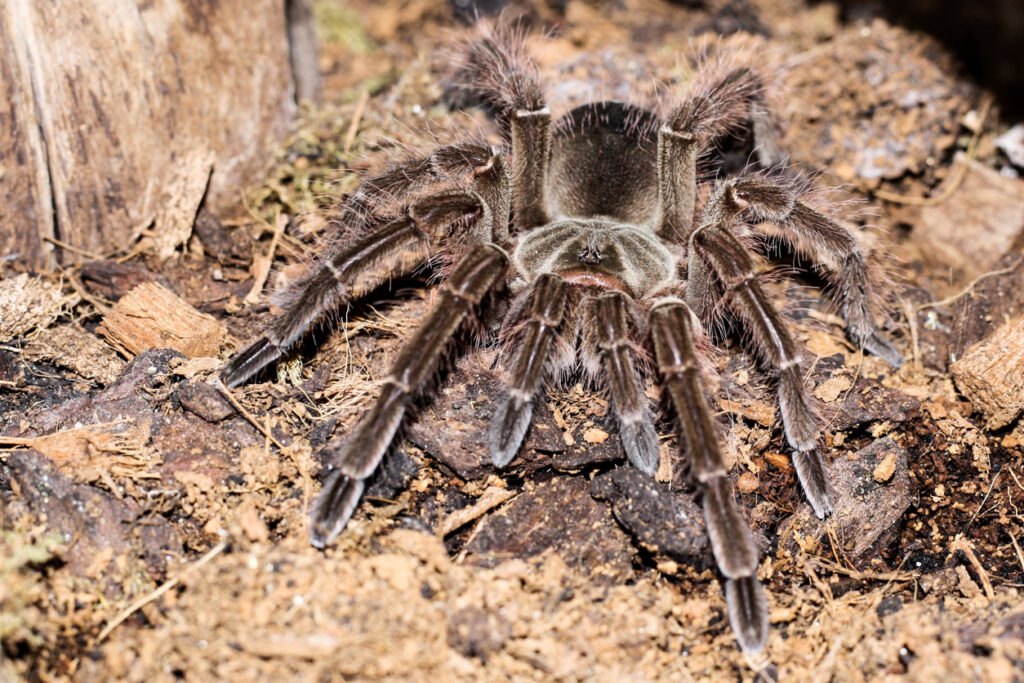The word arachnid stirs up feelings of fear and anxiety for many, with arachnophobia being one of the most common fears in the world! Is it the eight legs, or is it the multitude of eyes? We’re not sure, but we are sure that these creatures are seriously misunderstood.
They’re found all across the world because of their remarkable adaptability. Types of arachnids include spiders, scorpions, ticks, and mites, among many others. You’re probably more than familiar with spiders because they’re incredibly common across the UK with examples like the common zebra spider, the giant house spider, and the wolf spider.
In this blog, we’re going to take a look at some awesome arachnids and why they’re worth visiting during your next trip to Blue Planet Aquarium.
What is an Arachnid?
Arachnids are chelicerates, one of the five groups of the phylum Arthropoda, which loosely means ‘jointed foot’. These arthropods are primarily carnivorous, wingless, have 8 legs and a hard exoskeleton.
The spiders and scorpions have a jointed body, split into two segments, whereas other groups like daddy longlegs (harvestmen), ticks and mites have just one visible segment.
Due to their remarkable adaptability, arachnids are found on every continent around the world except for Antarctica. Here in the UK, we’re not fortunate enough to see many of the different types, apart from spiders, mites and ticks.
Types of arachnids
As mentioned, there are several species that are classes at arachnids, so let’s take a closer look at some of these species:
Spiders
Spiders are probably the most well-known members of the arachnid family, and for good reason! With eight legs, multiple eyes, and the ability to spin silk, they’re expert hunters found in nearly every corner of the world.
Most spiders build webs to trap their prey, but some, like jumping spiders and wolf spiders, prefer to stalk and pounce on their food.
While many people are scared of them, the truth is that most spiders are completely harmless to humans and actually help keep insect populations under control.
Scorpions
Scorpions might look intimidating with their powerful pincers and venomous stingers, but they’re actually fascinating animals that have been around for over 400 million years!

Scorpions are nocturnal hunters who thrive in deserts, forests, and even grasslands, using their well-tuned senses to track down prey. They mainly feed on insects, though some larger species can take on small lizards or rodents.
One of their most unique features is their ability to glow under UV light, which is handy for researchers studying them in the wild!
While a scorpion sting can be painful, most species aren’t dangerous to humans, and, like other arachnids, play an important role in maintaining the balance of their ecosystems.
Ticks
Unlike other arachnids that hunt or scavenge, ticks are parasitic, feeding on the blood of mammals, birds, and reptiles. They’re found in grassy or wooded areas, patiently waiting for a host to pass by so they can latch on.
Once attached, a tick can stay in place for days, growing larger as it feeds. While their bites are usually painless, ticks are known for spreading diseases like Lyme disease and Rocky Mountain spotted fever, making them a concern for both animals and humans.
Despite their bad reputation, they’re still an important part of the food chain, serving as a meal for birds and other predators.
Mites
Mites are the tiniest members of the arachnid family, often invisible to the naked eye. They live just about everywhere – on plants, in soil, in water, and even on animals, including humans!
While some mites are harmless or even helpful, others can cause issues, such as skin irritations in animals or damage to crops. Dust mites, for example, thrive in homes, feeding on dead skin cells, while spider mites are known to attack plants.
Key differences between insects and arachnids
At a glance, insects and arachnids are easy to mistake for one another. The two easy-to-spot differences between the two are:
- Body segments: While arachnids have two body segments, insects have three body segments. This is probably the easiest thing to spot even at a distance.
- Number of legs: This might be difficult to spot, but if you can get close enough, you’ll be able to see that insects have six legs compared to arachnids’ eight legs.
Arachnids at Blue Planet Aquarium
At Blue Planet Aquarium, we’re ecstatic about arachnids which is why we’ve got so many of them on display in our Venom Exhibit.
Goliath birdeater tarantula (Theraphosa blondi)
As names go, this one is pretty epic! Goliath birdeater tarantula! Not only is it a cool name, but it’s also an apt name for this wonderful arachnid. This arachnid is so large that it can comfortably eat larger prey than your average spider. It’s the largest species of arachnid in the world by mass and the second biggest by leg span, reaching a span of 12 inches and weighing up to 6 ounces. Contrary to the name, these tarantulas very rarely eat birds, it just so happens that the first zoologist to discover them found one feeding on a hummingbird! Their main prey sources are large insects, frogs, small lizards and even rodents. Luckily, although these animals are venomous, it would just feel more like a wasp sting to us.

David Bowie huntsman (Heteropoda davidbowie)
Another arachnid with an incredible name. This orange spider is named after the famous singer David Bowie. With a particular reference to his fifth studio album “The Rise and Fall of Ziggy Stardust and the Spiders from Mars” and the concert film “Glass Spider”, these colourful spiders are a great example of sexual dimorphism, as the males are covered in distinct brightly coloured red and orange hairs lines of hair, whereas the female’s body appears more greyish and brown in colour.
Found across Southeast Asia, the David Bowie huntsman feeds on insects and even other spiders, subduing prey with its potent venom. Although their bite might be painful to humans, they’re generally considered pretty harmless to humans.
Indian social spider (Stegodyphus sarasinorum)
Unlike many species of arachnid, the Indian social spider is quite unique because they live in colonies rather than living on their own. This gives them a great advantage for hunting, allowing them higher success rates even when targeting larger prey.
Curly haired tarantula (Tliltocatl albopilosus)
The curly haired tarantula is native to Costa Rica and is a primarily nocturnal, opportunistic ambush predator that feeds on insects and small vertebrates such as frogs. They detect their prey by smelling through the hairs on their legs! These are called olfactory organs, and they can detect chemicals such as hormones from other animals through the hollow hairs at the end of each leg as well as their pedipalps. Once they have captured their prey, they inject venom that not only paralyses their prey but also immediately begins digestion. But don’t worry – this venom is not normally harmful to humans!
Mexican red rump tarantula (Tliltocatl vagans)
Like most tarantulas, they will eat anything they can overpower, which is usually insects, but small lizards and rodents may also be included in their diets. As their venom is nowhere near as potent as their neighbours, we just have to be weary about their ability to flick the hairs off of their abdomen that can embed into our skin.
Socotra Island blue baboon (Monocentropus balfouri)
The Socotra Island blue baboon is an opportunistic burrowing terrestrial spider that is uniquely communal. Mothers of this species care for their young, even attacking potential predators if they get too close to her egg sac. Multiple individuals of different ages can live together in peace, providing that they have enough food to go around, keeping competition low. When threatened, they do the characteristic “threat pose,” rearing up on the hind legs and baring their fangs. Further provocation can lead this tarantula to deliver a fast strike and bite, especially if protecting an egg sac.
Gooty ornamental tarantula (Poecilotheria metallica)
The gooty ornamental has a striking geometric body colouration showing as a metallic blue colour. This is probably the best example in the aquarium of an adaptation called aposematism, which is just a fancy way of describing when animals such as dart frogs are brightly coloured as a warning signal to potential threats to warn them of their potent toxins. While there has never been a recorded death from their bites, their venom is considered medically significant causing; an increased heart rate, swelling, cramping, and sweating lasting up to a week.
Asian forest scorpion (Heterometrus spinifer)
This species reaches around 11cm long and is known to use its large, highly developed, pincers to attack, as opposed to their tails. Although their venom is non-fatal to humans, it can cause severe pain. They spend their days buried under logs and leaf litter and come out at night to hunt, primarily insects but also occasionally small frogs and lizards too.
If we’ve managed to spark your curiosity for arachnids, come and join us in appreciating these remarkably diverse creatures in person. Book your tickets to Blue Planet Aquarium and head down to the venom zone to hear more info on our resident arachnids at 15:00 every single day!
